ANZINE : CAE 기술 매거진
이전 ANZINE Home Case Study
[Global] Creating new services based on reconstruction of accident kinematics with FEM prototypes and a design thinking approach
- F. Ardente, DCA Consulting
- A. Ortalda, C. Martin, EnginSoft
- marketing@tsne.co,kr
Creating new services based on reconstruction of accident kinematics with FEM prototypes and a design thinking approach
Fabio Ardente, DCA Consulting | Alfonso Ortalda and Claudio Martin, EnginSoft
Published in Futurities Year 19 n°1 by EnginSoft
■ Abstract
본 원고는 유한 요소법(Finite Element Method)과 디자인 씽킹(Design Thinking) 접근법을 결합하여 교통사고 보험 보고서를 위한 도로 교통사고를 재구성하고, 사고 결과를 분석하며, 각각의 재산 피해 및 보행자 또는 승객의 신체적 부상을 비교함으로써 보험사가 대형 청구 보상의 규모를 제한하는 동시에 고객에게 공정한 보상을 제공하여 보험사에 대한 신뢰와 신용을 강화하는 것을 목표로 한다. 또한, 회계 지표를 활용한 예시를 통해 유한 요소법과 디자인 씽킹 접근법을 결합한 이 전략이 기업에 미치는 부가가치를 5년 동안 요약 및 측정하는 사례를 제시한다. ※ 일부 기준은 국내 기준과 상이할 수 있습니다.
One of the first tasks that most teams and projects undertake is the exploration of an idea or solution in greater depth to boost critical thinking. The second priority is to use engineering solutions to harness critical business thinking. Design Thinking is an approach that looks at value and change from a people perspective, combining three factors:
• technology, how things are made, and their performance increased;
• people and the ways in which made things are valuable to customers;
• business and how organizations can profit from offering people these made things.
Design Thinking starts from a people perspective and tries to generate value for them by creating great, meaningful things, after which it seeks a profitable business model to convert this people value into business value. The assumption, therefore, is to first find people value (users and makers), and later, of course, do business. Design Thinking is key in our technology transformed world because it can harness this abundance of technology and data to create real value for customers; however engaging people in the digital transformation process is vital for every organization.
Design Thinking focuses primarily on understanding whether something is meaningful for people and starts with this change of perspective which brings with it a complete redesign in terms of mindset, processes, and tools. Profit is a consequence of creating things that are meaningful to people. The Design Thinking paradigm can take on different forms and interpretations depending on the nature of the purpose and the companies involved, and can be classified into four different clusters:
• Creative Problem Solving: solving difficult problems with analytical and intuitive thinking;
• Sprint Execution: delivering and testing viable products to learn from customers and improve the solution;
• Creative Confidence: engaging people to make them more confident with creative processes.
• Innovation of Meaning: envisioning new directions that aim at people-meaningful experiences (DT4B, 2019).
The multifaceted nature of Design Thinking has been divided into three key areas:
• Design Thinking SETUP explores the composition of the team and the goals of the Design Thinking project.
• Design Thinking PRACTICES aim at exploring the delivered project phases, the capabilities collected in the team and the attitudes embedded in the project activities.
• Design Thinking VALUE encompasses the value generated by the use of Design Thinking from two different perspectives: consultancy and client (DT4B, 2019).
For the purposes of our study we will consider two forms of Design Thinking, Creative Problem Solving and Sprint Execution, where the prototype takes on two types of meaning: in creative problem solving it expresses the genesis of incremental innovation that aligns customer needs with business objectives, while in the sprint execution, in the form of the minimum viable product (MVP), it forms the basis for developing the best product that generates the greatest possible value for the customer.
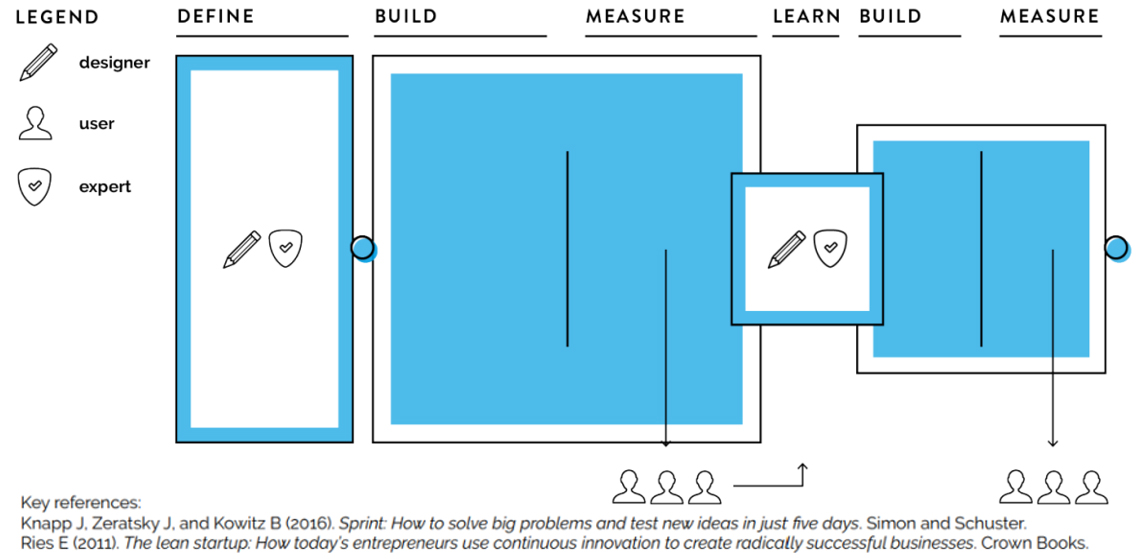
Fig. 1 - An example of an iterative Sprint Execution map.
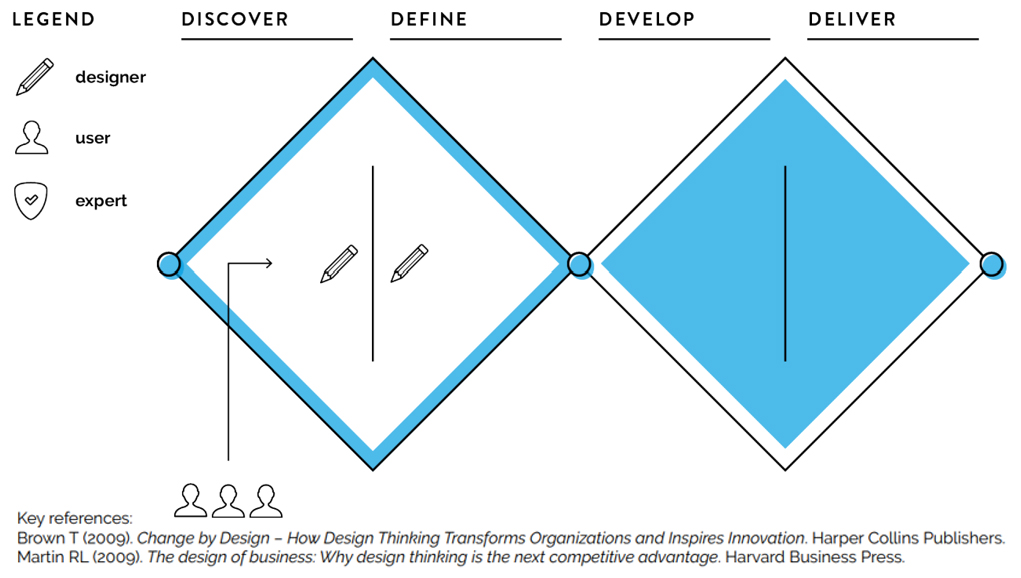
Fig. 2 - An example of an iterative Creative Problem-Solving map.
To enable a better understanding of this design philosophy, we will briefly describe the themes of each approach: Sprint Execution is characterized by a strong focus on delivering products or services that are ready for use in the market or in real-world contexts where they align with user needs. The product is the primary driver of capturing value and learning from market and user responses, and technology is used to accelerate delivery while constantly reviewing the settings in line with the initial design.
The approach is from the inside out: the consulting team expert designs the product/service and then refines it through the user experience, based on user/customer feedback and reactions. In other words, a product with the basic characteristics necessary to quickly satisfy the customer requirements is generated, accurately identifying the prototype as a minimum viable product (MVP).
Another approach is Creative Problems Solving. Creative Problem Solving assumes that users have a need or a problem and the best possible solution must be sought. The innovation team must intercept these user needs by analysing the product. The assumption of the research path is that the more ideas that are analysed as the best solution to the problem, the greater the chances of actually finding the right solution to the problem. Idea generation is about sharing detailed information with the team, interpreting big data, and identifying design opportunities.
The Creative Problem-Solving approach moves from the outside in. It starts by observing how users interact with the product in the real world and then interprets those observations by empathizing with users to create original solutions. The prototype, which has to interact with the user, has to be developed from a combination of lateral thinking and new perspectives, rational thinking and strong imagination, seeking inspiration everywhere and in all contexts, with alternating convergent and divergent phases of solution creation until the most promising solutions are identified.
The Double Diamond created by the Design Council represents the design process: while the first diamond focuses on designing the right thing, the second focuses on designing things right. It can be organized into four clear phases:
• Discover: Discover insights into the user and business requirements through a range of research methods (interviews, focus groups, etc.);
• Define: By using the insights gathered, and interpreting and aligning user needs and business goals, the teams identify and converge on project objectives and define the scope for feasible, achievable, and desirable outcomes;
• Develop: To find the best solution, teams use questions such as “How could we…?” to establish hypotheses and test them internally. A proof of concept is created through rapid prototyping and iteration processes. To ensure that teams are on the right track, they need to test and validate the proof of concept externally with end users. Through this validation, they make abstract concepts more concrete;
• Deliver: In the fourth phase, the resulting project (product, service, or system) is refined and launched (DT4B, 2019).
After this necessary introduction, we contend that the use of the finite element method (FEM), with appropriate adaptations, is ideally suited to the creation of products/services due to its ability to generate a large number of prototypes in a very short time after the appropriate simulations which allow the right solution to be identified. FEM prototyping takes on two meaning at once in this particular field of application: the first is in the context of the Kinematic Reconstruction Report, which through many simulations provides an excellent historical scenario of the facts and thus part of the physical-mathematical result sought; the second is more closely related to improving the userism of the Kinematic Report (intended as a prototyping phase of Design Thinking - Creative Problem Solving and Sprint Execution), for example by deciding which and how many curve graphs to use, how many and which videos are more representative to support the intended uses.
In the case studied, an “ex post” reconstruction of the kinematics related to traffic accidents and injuries is possible thanks to the combined use of FEM calculations and Design Thinking to produce a final report tailored to different applications: settlements, civil, and criminal court cases.
■ FEM analysis case study
In the automotive industry, numerical simulation has been widely used for decades because increasingly stringent safety requirements pose engineering challenges to find the best compromise between crashworthiness performance, structural weight, design and production costs. In this case study, impact scenarios are defined by regulation, and simulation allows biomechanical parameters to be determined on dummies without building expensive prototypes. The logical flow is completely different for the presented application and the method can be roughly divided into three macro phases:
1. By collecting and interpreting data from the field (road measurements, vehicle damage, medical reports, witnesses, and other evidence), experts define a possible impact scenario with a certain margin of uncertainty.
2. A numerical simulation of the event finds the initial conditions compatible with the impact dynamics and the final state in terms of overall kinematics and damage. Therefore, when conditions are not fully known (e.g. passenger wearing a seatbelt or not) or some of the data collected is not entirely reliable, simulation permits the definition of those hypotheses that are compatible with the reliable data (Step 1).
3. Once the numerical model has described the event, a what-if analysis can be performed to study whether the evolution of the accident might have been different if the initial conditions had been modified.

Fig. 4 - FEM model
※ LS-DYNA, the most common software tool for crashworthiness analysis has been used for this activity.
■ Scenario description
The scenario has been reproduced by analogy with other accidents but does not reflect any real case, for obvious reasons. Nevertheless, the case study presented is representative of a general approach to the problem. In general, there are three types of data available:
• Reliable data known with accuracy (e.g. vehicle damage);
• Reliable data which is not known with accuracy (e.g. angle of impact);
• Data to be verified (e.g. witness testimonies).
Data of type 1 and type 2 forms the basis for the reconstruction of the crash dynamics. In the presented case, the data corresponding to the categories is classified as follows:
• Type 1: Vehicle type, scooter type, damage to the vehicle, damage to the scooter, police report and measurements, medical report;
• Type 2: Speed and position (GPS) of the vehicle and scooter;
• Type 3: Witnesses.
With this information it was possible to define the following impact conditions:
• Vehicle speed between 5 and 15 kph
• Scooter speed between 30 and 40 kph
• Angle of impact between 25 and 35 degrees
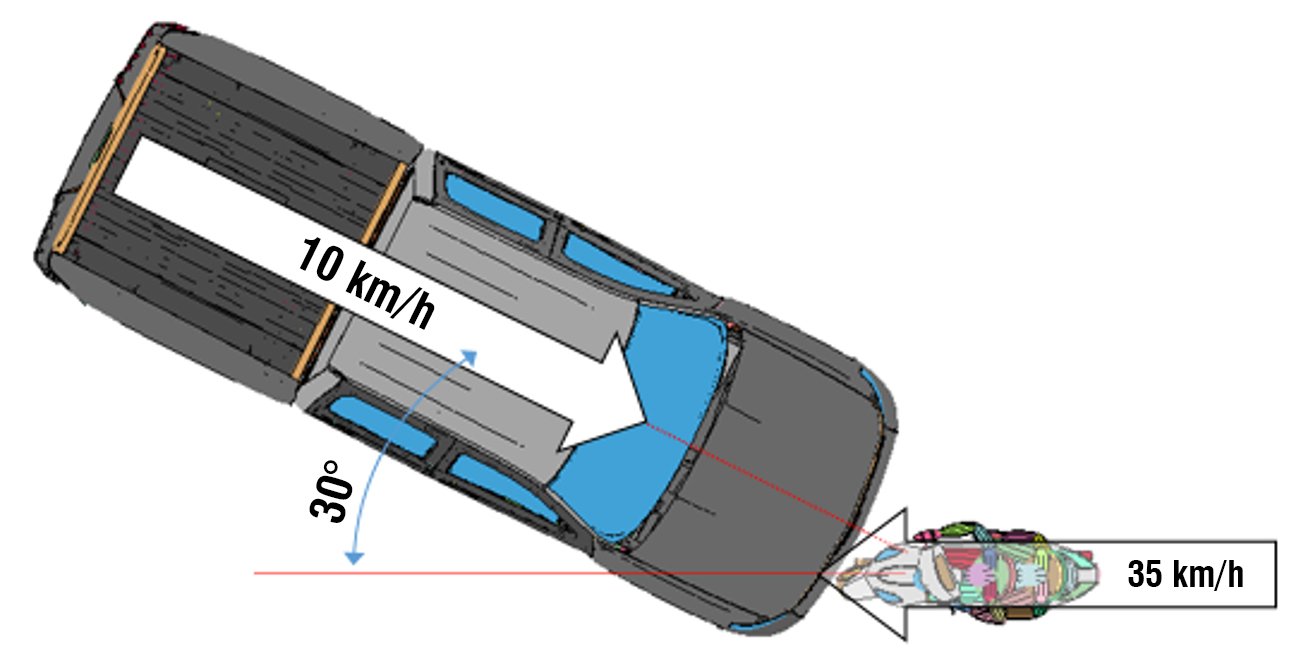
Fig. 3 - Impact scenario.
The exact values of the mentioned quantities and other conditions are defined on the basis of the correlation between the simulation results and the data available from the field.
Therefore, when there are too many variables and combinations to be managed “by hand”, the results need to be processed in a statistically advanced manner. It is possible to consider using a multidisciplinary, multi-objective optimizer to manage the workflow automatically. This approach will not be presented in this paper.
■ Model description
The FEM model consists of a pick-up truck, a scooter and two dummies. With regard to the pick-up truck involved (specific libraries could be implemented as a service), the starting point is a model of the same class with similar external characteristics so as to have an equivalent impact surface. The first step is to check and possibly update the mass distribution.
The second step is to remove any unnecessary parts that are distant from the impact area; this reduces the number of elements and therefore the simulation time. The third step is to perform preliminary crash tests in order to finetune the correct behaviour of the vehicle with particular attention to the impact area; specifically, the plastic deformation, damage and breakage of the frontal part (wings, bumpers, car cross-beam, crash box, windscreen, headlights, etc.) must be similar to that experienced by the real vehicle.
A new model was developed for the scooter. Considering the impact conditions, the activities covered the following aspects:
• Geometry and mass - main dimension and mass distribution;
• Geometry and mechanical resistance of the front shield (driver’s side);
• Suspension and steering kinematics.
The second element is fundamental because the rider’s legs will hit the shield during the first milliseconds of the impact and therefore the structural behaviour will influence both the leg injuries and the projection of the rider over the fairing towards the front of the vehicle. The plastic shield was thoroughly investigated to define its behaviour relevant to the field evidence in terms of damage to the vehicle.
Suspension modelling, mainly fork stiffness, is very important because it determines the lowering of the scooter during impact and therefore influences the forward projection of the rider and passenger. The spring stiffness was defined according to the information available in the spare parts catalogue. As far as the dummies are concerned, the methodology involves the use of a “fast” dummy to reconstruct the accident in order to determine the impact conditions for the more traumatic events for motorcyclists in terms of position and speed (head against the bonnet in this case).
These incipient impact conditions will be used as initial conditions for a human dummy in order to assess the injury risks. This approach drastically reduces CPU time and, in addition, increases run stability which is sometimes a critical numerical issue for the dummy due to the combination of long termination times, severe local contacts, and foam modelling.
It is important to note that the duration of a traditional crash test is typically 200 milliseconds while in the case of an accident reconstruction the duration can be seconds. It is mandatory to reduce the number of elements as far as possible to avoid numerical problems that could lead to numerical instabilities.
The “fast” dummies consist of rigid bodies representing the different parts of the body in mass and shape, joined by kinematic joints that represent the joints of the body. The contact stiffness considers the compliance of the human body in a simplified manner.
Although simple, in most cases “fast” dummies are well suited to reproducing the dynamics of an accident.
■ Dummy positioning
The dummies chosen for this activity are called GEBOD and are rigid body dummies automatically generated by the solver.
There is a choice of three types of human subject: male, female, and genderless child.
The physical properties of these dummies are based on the GEneraton of BODy database, an extensive human measurement programme conducted by government agencies. Likewise, the motion of the dummy is represented by a multi-body system of rigid segments governed by differential equations.
The interaction between the finite element structure and the dummy is achieved through conventional contact interfaces. The dummy positioning is quite different from the conventional one.
Due to the fact that embedded models are not compiled until the simulation is run, correctly positioning the occupants in a model can be a tedious, trial-and-error effort. Stand-alone models are easier to position but are more CPU intensive. For the purposes of this accident reconstruction simulation, the built-in *COMPONENT_ GEBOD model was selected for integration and evaluation.
Specifically, the user must create a file named gebod.dummyID that has to reside in the directory with the LS-DYNA input file. The positioning file consists of 40 lines of code relating to the angular measurements of the body segments.
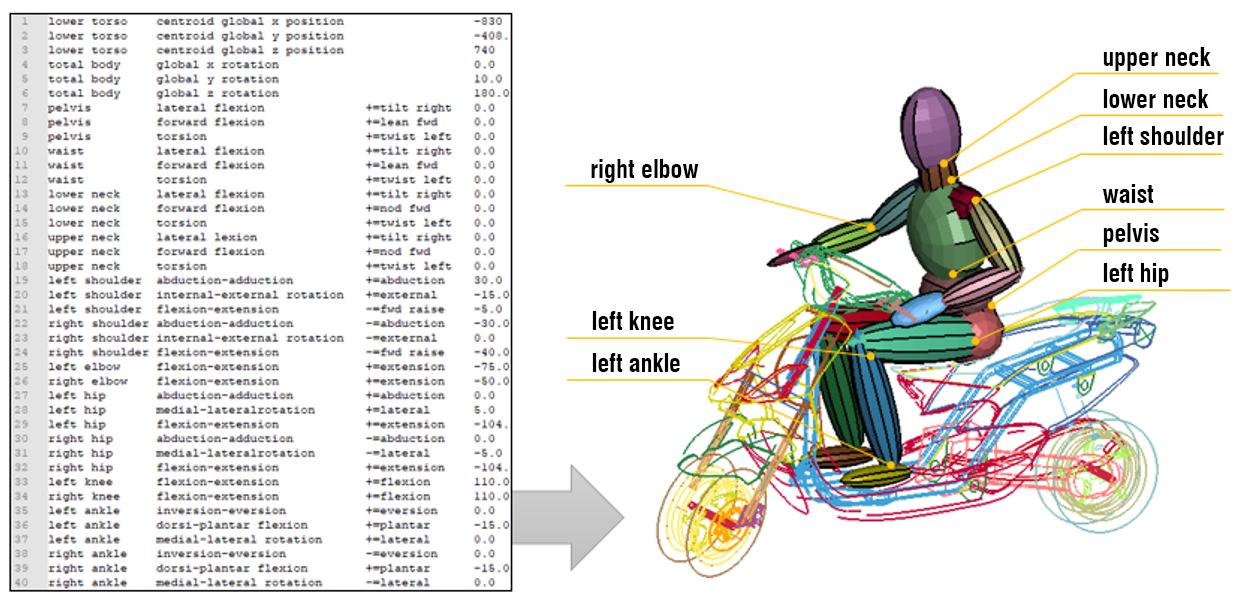
Fig. 5 - GEBOD positioning file.
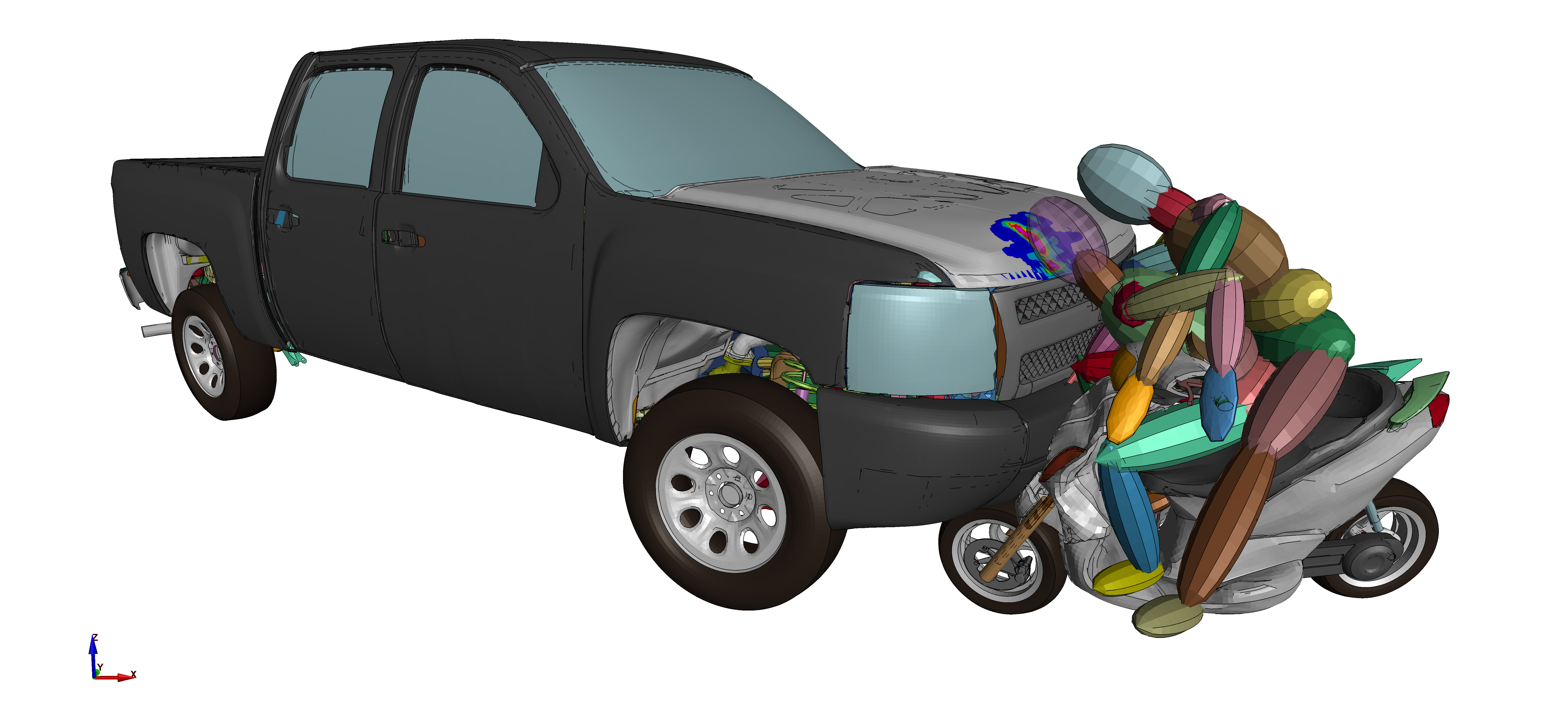
Fig. 6 - Frame at the time of head impact.
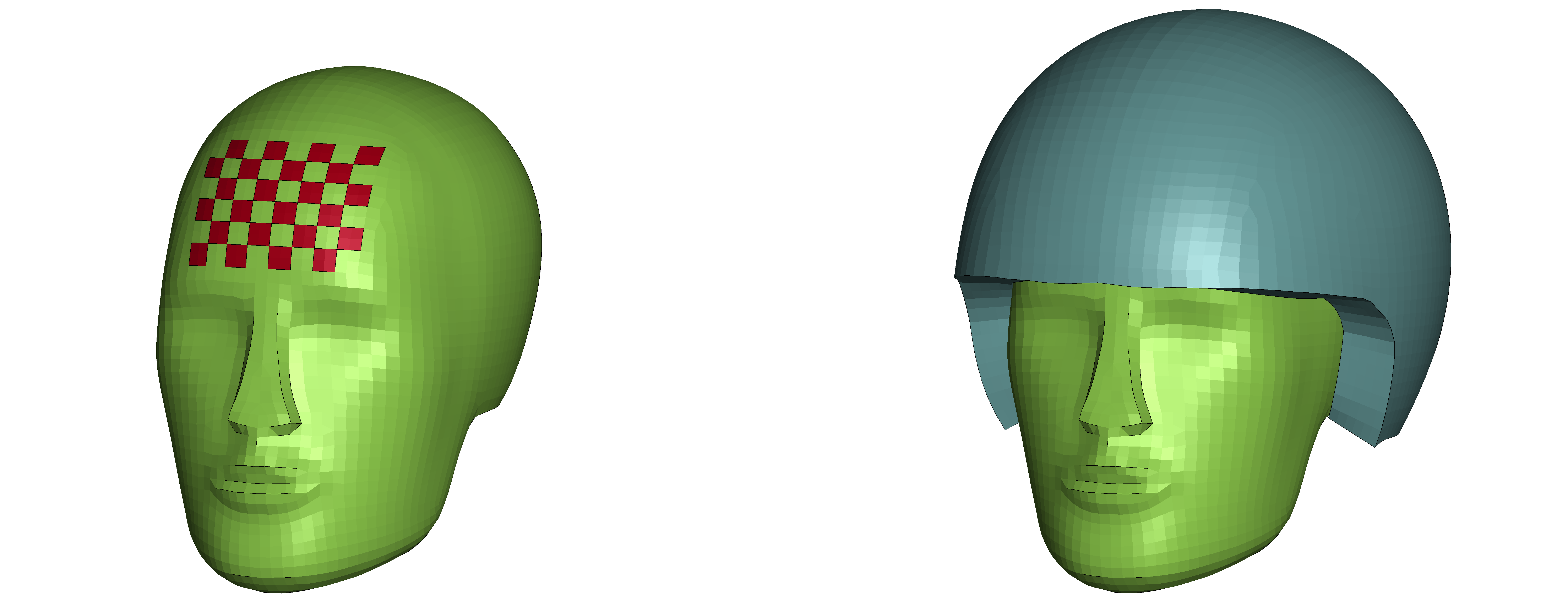
Fig. 7 - LSTC Head and Helmet models.
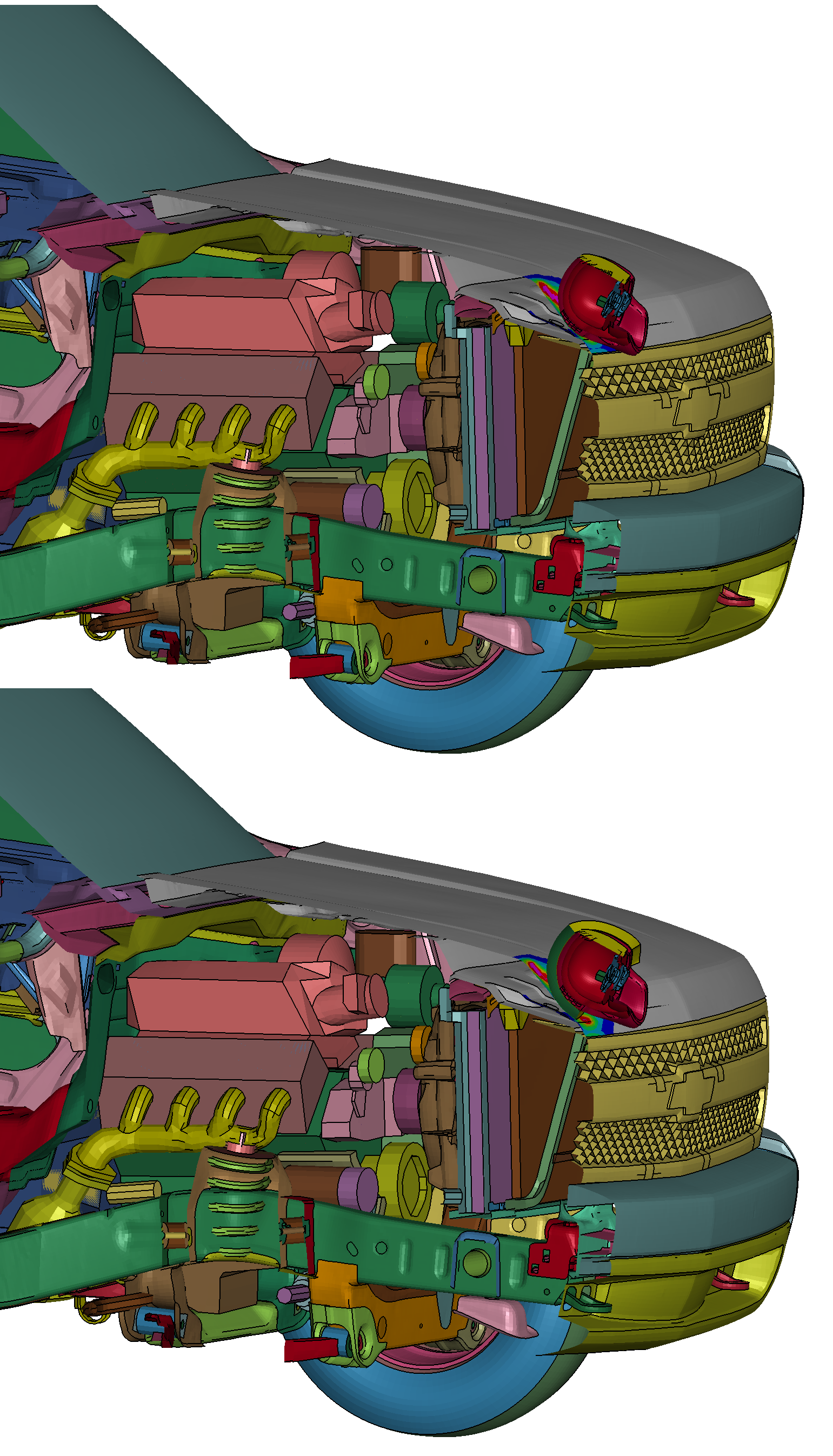
Fig. 8 - Section at time of head impact (without and with helmet).
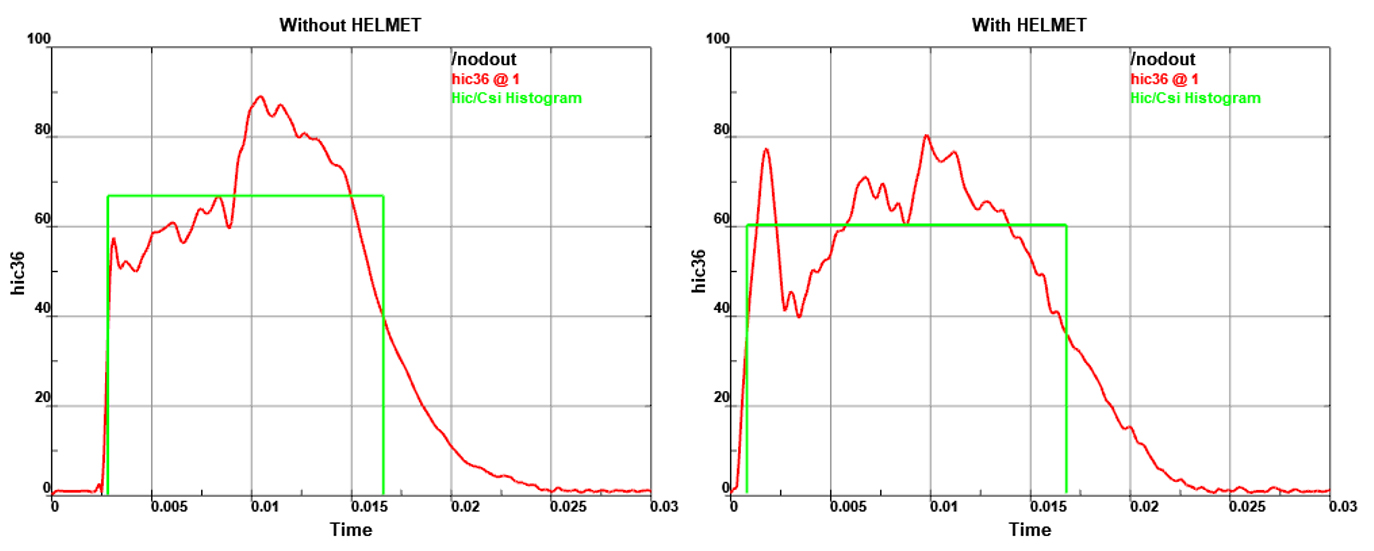
Fig. 9 - Head acceleration diagrams.
■ Sub model description and initialization
In the case history presented the objective was to evaluate the head injuries with and without a helmet in order to define whether, in the real accident, the rider was wearing a helmet correctly or not.
As described before, thanks to the dynamic reconstruction with “fast” dummies, the impact conditions responsible for the main injuries are now available.
These conditions are the “initial conditions” for a submodel in which the simplified headform is replaced with a new model capable of assessing injury risks. The LSTC Free Motion Headform, a Hybrid III-type dummy head used to assess head injuries inside a vehicle and equipped with accelerometers to measure head acceleration during impact in order to calculate head injury criteria, was used.
The helmet is made of an expanded polystyrene (EPS) foam with a polycarbonate shell.
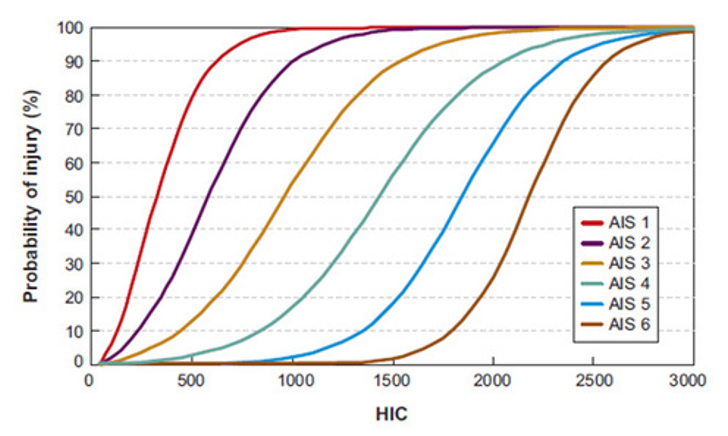
Fig. 10 - AIS-HIC diagram.
■ Results and discussion
Using the model discussed above it is possible to extract the amount of injury to the instrumented head for the two cases (with and without the helmet).
The result with the helmet shows a decrease in the acceleration peak and a smoother curve due to the absorption of the charged energy by the protective foam of the helmet.
The most commonly used criterion for assessing head injuries in the automotive industry is called HIC (head injury criterion), and measures the risk of injury in terms of prolonged linear acceleration for durations of between 15 and 36 milliseconds. This criterion attributes brain damage measuring translational acceleration.
Alongside the HIC, for some specific brain injuries, other measuring instruments also analyse the rotational effects, known to be important for causing the deformation of the brain cut. Some of these are combinations of linear and rotational acceleration, and some are entirely based on head rotation, namely the Brain Damage Criterion (BrIC), the Rotational Damage Criterion (RIC), and the Power Rotational Head Injury Criterion (PRHIC). The presented work, however, focused on the relationship between HIC and human trauma. Biomechanics experts agree that an HIC score of 1000 represents the “safe” limit for human tolerance, above which the risk of a severe head injury is nonzero.
In the scenarios analysed for the case study, the presence of the helmet reduced the HICd (dummy head injury criterion) value from 550 to 500, showing that the helmet clearly mitigates the consequences of the accident to the rider. As mentioned, the potential for head injury can be quantified using the Head Injury Criterion (HIC), which is calculated as a function of the magnitude and time duration of head acceleration. In the context of road traffic and accident insurance reconstructions, the required output is not a score, however, but rather an assessment of the trauma suffered. For this purpose, the HIC values were correlated with the Abbreviated Injury Scale (AIS), which codifies the severity of injuries to all regions of the body.
The AIS incorporates current medical terminology, providing an internationally accepted tool for ranking injury severity. It is an anatomically based global severity scoring system that classifies an individual injury by body region according to its relative severity on a 6-point scale (1=minor and 6=maximum) and is the basis for the calculation of the Injury Severity Score (ISS) of the patient with multiple injuries.
Conclusion
One of the main objectives of the work presented here was to demonstrate that the use of numerical simulation is a fundamental tool in the reconstruction of road traffic and accident insurance reports.
The work focuses on the use of the finite element method (FEM) to analyse the outcome of an accident, and whether input parameters can modify the scenario. In addition, the work focuses on the assessment of the level of head trauma using the Head Injury Criterion and links it to the AIS scale.
The behaviour of pick-up trucks, scooters and dummies is assessed using full three-dimensional models of complete vehicles, a helmet, dummies, and heads. The results are presented and discussed in terms of HIC values and the probability of acceleration-induced trauma to assess the relevance of the helmet in terms of injury to the rider.
From the results obtained in the scenario analysed, it can be seen that the presence of the helmet reduced the HICd value from 550 to 500, leading to a reduction of serious injuries.
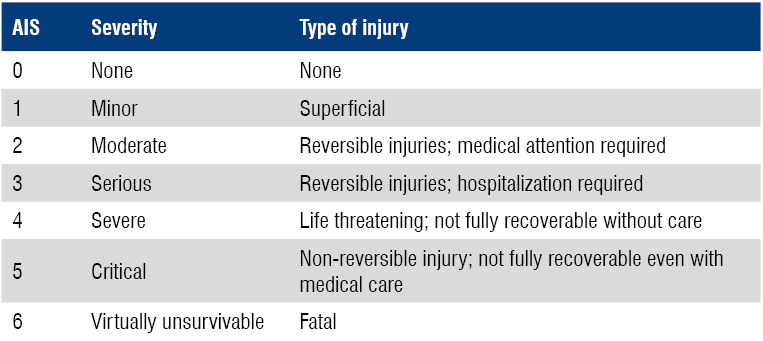
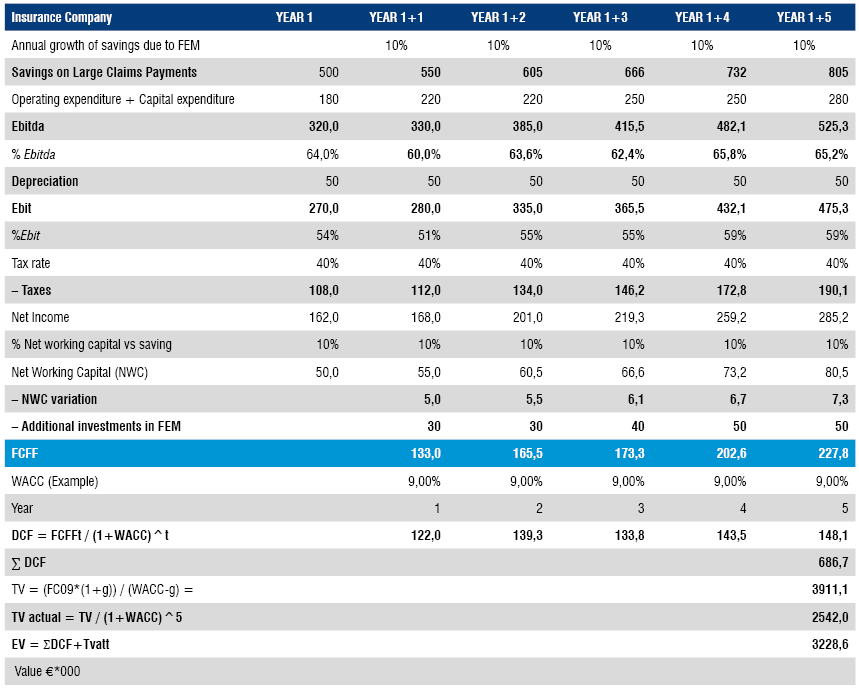
As the use of FEM in the field of the kinematic reconstruction of car accidents impressively demonstrates, the relative compatibility of the respective property damage between several vehicles enables economic value to be calculated, both as a decision support tool in the insurance case, by analysing the compatibility of physical injuries to pedestrians or passengers through methods derived from design thinking that have a direct impact on the insurance company’s profit and loss account, and as value creation for the consumer, improving the customer experience by fairly quantifying compensation, leading to greater brand loyalty and advocacy, which generally improves trust and credibility in the insurance market. Like any new and innovative tool, FEM must find an appropriate role to support:
• strategic planning (business model canvas, balanced scorecard, budgeting)
• management control, ex-ante evaluation of the cost-effectiveness of the project investment and of the actual cash flow generation by the prototype.
For the sake of simplicity, we will use accounting indicators to summarise and measure the performance of a company. More precisely, we can divide the indicators into three groups:
• A first set of indicators is derived from ROE, which measures the ratio of profit generated to capital employed: if this ratio is positive, profits are higher than the cost of capital.
• A second set of indicators, derived from Residual Income (RI), identified as Economic Value Added (EVA), measures economic performance as the difference between the profit generated and the cost of capital employed. When RI is greater than or equal to zero, profits are greater than the cost of capital.
• A third group of indicators called Value Based, adjusts the previous two methods and replaces profit with cash flow.
We will focus on the third group of indicators by looking at them through an expected Discounted Cash Flow (DCF) simulation. This is a valuation method that estimates the value of an investment based on its expected future cash flows. As shown in the example below, we can see how the FEM methodology brings significant profits to the company and proportionally reduces the investments associated with the new technology year after year.
Example:
• For Year 1, we set a target of saving €500,000 in large claims compensation. We also allocated a reasonable amount of €180,000 for operating costs and capital expenditure.
• Assuming a 10% annual growth in large claims savings, we can realistically calculate a total DCF of around €690,000.
• Assuming a cost of capital (WACC) of 9%, the Enterprise Value (EV) of the investment reaches €3.2 million.
For more information :
-Fabio Ardente | DCA Consulting
- email : fabio.ardente@dcaconsulting.it
■ About DCA Consulting
DCA Consulting was founded in 2001 and targets corporates in the specific areas of claims, collections management, and strategic-organizational consultancy, offering highly innovative operational solutions through digital solutions designed around customer centrality.
The company addresses a stimulating and engaging work environment specializing in the professional management of networks and digital solutions designed for business process management and people management in the insurance, banking, and automotive sectors.
The DCA Innovation division was established in 2015 to focus on the design and development of software to support innovation and digital transformation through Design Thinking.








 ㈜태성에스엔이
㈜태성에스엔이


